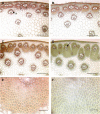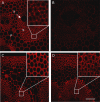Characterization of a cinnamoyl-CoA reductase 1 (CCR1) mutant in maize: effects on lignification, fibre development, and global gene expression
- PMID: 21493812
- PMCID: PMC3134344
- DOI: 10.1093/jxb/err077
Characterization of a cinnamoyl-CoA reductase 1 (CCR1) mutant in maize: effects on lignification, fibre development, and global gene expression
Abstract
Cinnamoyl-CoA reductase (CCR), which catalyses the first committed step of the lignin-specific branch of monolignol biosynthesis, has been extensively characterized in dicot species, but few data are available in monocots. By screening a Mu insertional mutant collection in maize, a mutant in the CCR1 gene was isolated named Zmccr1(-). In this mutant, CCR1 gene expression is reduced to 31% of the residual wild-type level. Zmccr1(-) exhibited enhanced digestibility without compromising plant growth and development. Lignin analysis revealed a slight decrease in lignin content and significant changes in lignin structure. p-Hydroxyphenyl units were strongly decreased and the syringyl/guaiacyl ratio was slightly increased. At the cellular level, alterations in lignin deposition were mainly observed in the walls of the sclerenchymatic fibre cells surrounding the vascular bundles. These cell walls showed little to no staining with phloroglucinol. These histochemical changes were accompanied by an increase in sclerenchyma surface area and an alteration in cell shape. In keeping with this cell type-specific phenotype, transcriptomics performed at an early stage of plant development revealed the down-regulation of genes specifically associated with fibre wall formation. To the present authors' knowledge, this is the first functional characterization of CCR1 in a grass species.
Figures




References
-
- Bai Y, Gong W, Liu T, Zhu Y. Cloning and expressional analyses of a cinnamoyl CoA reductase cDNA from rice seedlings. Chinese Science Bulletin. 2003;48:2221–2225.
-
- Bailleres H, Castan M, Monties B, Pollet B, Lapierre C. Lignin structure in Buxus sempervirens reaction wood. Phytochemistry. 1997;44:35–39.
-
- Barriere Y, Thomas J, Denoue D. QTL mapping for lignin content, lignin monomeric composition, p-hydroxycinnamate content, and cell wall digestibility in the maize recombinant inbred line progeny F838 x F286. Plant Science. 2008;175:585–595.
Publication types
MeSH terms
Substances
LinkOut - more resources
Full Text Sources
Other Literature Sources
Molecular Biology Databases
Research Materials

